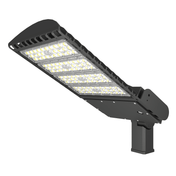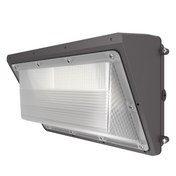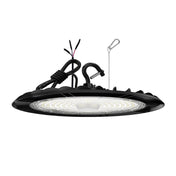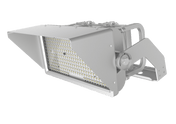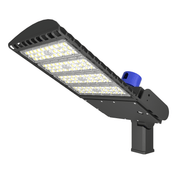UFO vs Linear LED High Bay Lights: What’s the Key Difference & Which to Choose?
In commercial and industrial lighting, LED high bay lights have become the mainstream choice due to their energy efficiency, long lifespan, and superior illumination. However, when it comes to selecting the right type, two designs often stand out: UFO LED high bay lights and linear LED high bay lights. While both serve the same core purpose—lighting large, high-ceiling spaces—their structural designs, optical performances, and application scenarios differ significantly. This blog will break down their key differences, help you understand which fits your needs, and avoid common selection mistakes.
1. Basic Definitions: What Are UFO and Linear LED High Bay Lights?
Before diving into comparisons, it’s essential to clarify the fundamental characteristics of each type, as their names already hint at their distinct appearances.
Named for their resemblance to a UFO (Unidentified Flying Object), these lights feature a compact, circular, and dome-shaped design. Typically, they integrate the LED chip, driver, and heat dissipation system into a single, streamlined housing. This all-in-one structure makes them highly portable and easy to install. UFO high bays are known for their concentrated light output and are often used in spaces where uniform, downward illumination is a priority.
1.2 Linear LED High Bay Lights
As the name suggests, linear LED high bays have an elongated, rectangular shape, similar to fluorescent tube lights but with a more robust build. They usually consist of one or more long LED strips mounted on an aluminum housing, paired with a dedicated driver (either integrated or external). Their linear design allows for wider light coverage along the length of the fixture, making them ideal for spaces with narrow or elongated layouts.
2. 6 Key Differences Between UFO and Linear LED High Bay Lights
To make an informed decision, let’s compare the two types across six critical dimensions: structural design, optical performance, heat dissipation, installation, maintenance, and cost.
2.1 Structural Design & Space Adaptability
UFO high bays have a small footprint due to their circular shape, which means they take up less ceiling space. This makes them perfect for areas with complex ceiling structures (e.g., pipes, beams) or limited mounting points. On the other hand, linear high bays have a longer, slimmer profile that aligns well with linear architectural elements, such as warehouses with row-based storage racks or retail spaces with long aisles. For example, a warehouse with narrow aisles between pallet racks will benefit more from linear lights, as they can cover the entire aisle length without creating dark spots.
2.2 Optical Performance: Coverage & Uniformity
Optical performance is where the two types differ most significantly. UFO high bays typically use wide-beam angle lenses (60°–120°), which distribute light in a circular pattern. This results in excellent downward illumination and is ideal for open spaces like gymnasiums or exhibition halls where 360° uniform light is needed. However, their coverage can be limited in elongated areas, leading to uneven lighting if spaced too far apart.
Linear high bays, by contrast, use narrow-to-medium beam angles (30°–90°) along the length of the fixture, creating a rectangular light pattern. This allows them to cover longer distances horizontally, ensuring consistent brightness along aisles or production lines. For instance, in a manufacturing plant with long assembly lines, linear high bays can light the entire line evenly, reducing eye strain for workers.
2.3 Heat Dissipation Efficiency
Heat dissipation directly impacts the lifespan and stability of LED lights. UFO high bays often use radial heat dissipation fins around the dome, which spread heat outward in all directions. This design is efficient for compact fixtures, as it maximizes the heat dissipation area relative to the size. However, in extremely hot environments (e.g., foundries), the concentrated heat may require additional cooling measures.
Linear high bays leverage their elongated aluminum housing as a heat sink. The large surface area of the housing allows heat to dissipate quickly along the length of the fixture. This makes them more suitable for high-temperature settings, as the heat is distributed over a wider area rather than concentrated in one spot. Additionally, some linear models feature built-in heat pipes for enhanced thermal management.
2.4 Installation Complexity & Flexibility
UFO high bays are generally easier to install due to their lightweight and compact design. They can be mounted using hooks, chains, or ceiling brackets in just a few steps, making them a favorite for retrofitting projects where time is limited. However, their fixed circular coverage means less flexibility in adjusting the light direction.
Linear high bays require more planning during installation, as they need to be aligned with the space’s layout (e.g., aisles, production lines). They can be mounted via surface mounting, suspension, or track systems, and some models offer adjustable angles to fine-tune the light direction. While installation takes slightly longer, the flexibility pays off in spaces with specific lighting requirements.
2.5 Maintenance & Durability
UFO high bays have an all-in-one design, which means if one component (e.g., driver) fails, the entire fixture may need to be replaced. However, their simple structure and fewer moving parts reduce the risk of mechanical failure. Most high-quality UFO models come with a 5–10 year warranty, minimizing maintenance concerns.
Linear high bays often have modular components, allowing for easier replacement of individual parts (e.g., LED strips, drivers). This reduces maintenance costs, as you don’t have to replace the entire fixture if one part malfunctions. Additionally, their elongated housing is less prone to damage from falling objects in industrial settings, making them more durable in high-traffic areas.
2.6 Cost: Initial Investment & Long-Term Savings
In terms of initial cost, UFO high bays are often more affordable for small to medium-sized spaces, as their compact design requires fewer materials. For example, a 100W UFO high bay typically costs 10–20% less than a comparable linear model.
However, linear high bays offer better long-term value in large, elongated spaces. Their wider coverage means you need fewer fixtures to light the same area, reducing both the initial purchase quantity and long-term energy costs. For a 10,000 sq. ft. warehouse, using linear high bays might require 20% fewer fixtures than UFOs, leading to significant savings over time.
3. Which One to Choose? Application Scenario Recommendations
The choice between UFO and linear LED high bays depends on your specific space and lighting needs. Here are targeted recommendations for common scenarios:
3.1 Best for UFO LED High Bay Lights
-
Open Spaces with High Ceilings: Gymnasiums, exhibition halls, and indoor sports arenas—where uniform 360° illumination is essential.
-
Small to Medium Warehouses: Spaces with random storage layouts rather than fixed aisles.
-
Retail Stores with Open Layouts: Department stores or supermarkets where the circular light pattern highlights merchandise evenly.
-
Retrofitting Projects: When replacing old metal halide lights and minimal installation time is a priority.
3.2 Best for Linear LED High Bay Lights
-
Elongated Spaces: Warehouses with narrow aisles, production lines, and distribution centers—where long, uniform coverage along the length is needed.
-
High-Temperature Environments: Foundries, steel mills, and bakeries—where superior heat dissipation is critical.
-
Commercial Kitchens: Long, narrow kitchen spaces where light needs to cover countertops and cooking areas without shadows.
-
Office Buildings with High Ceilings: Open-plan offices or atriums where the linear design complements modern architecture.
4. Expert Buying Tips for Both Types
Regardless of which type you choose, keep these key factors in mind to ensure you select a high-quality product:
-
Check Luminous Efficacy: Aim for ≥130 lumens per watt (lm/W) to ensure energy efficiency.
-
Verify IP Rating: For damp or dusty environments (e.g., warehouses, kitchens), choose IP65 or higher for water and dust resistance.
-
Consider Dimming Options: 0–10V or DALI dimming allows you to adjust brightness and save energy during low-traffic hours.
-
Look for Quality Certifications: Products with CE, RoHS, or DLC certifications meet international safety and performance standards.
-
Evaluate Warranty: A 5-year warranty or longer indicates the manufacturer’s confidence in the product’s durability.
5. Conclusion
UFO and linear LED high bay lights are both excellent lighting solutions, but they excel in different scenarios. UFO high bays are compact, affordable, and ideal for open spaces, while linear high bays offer superior coverage for elongated areas and better heat dissipation. By understanding their key differences and matching them to your space’s layout and needs, you can maximize energy savings, improve illumination quality, and reduce maintenance costs. Whether you’re upgrading a warehouse, retail store, or industrial facility, the right choice will enhance both functionality and efficiency.




